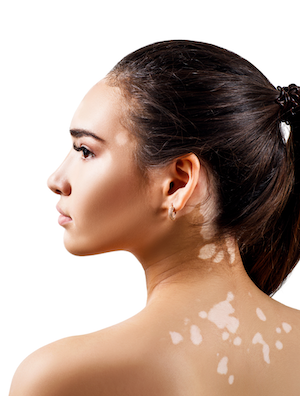Vitiligo

Learn more about vitiligo and the treatment options available.
Vitiligo is a non-life-threatening skin condition which causes patches of skin to lose color. It can also cause loss of pigmentation of the hair, mouth and the eyes. Vitiligo occurs when the cells that produce melanin (pigment) die.
Causes
Vitiligo is caused by the death of melanocytes or pigment cells. The cause is unknown, but it has been linked to autoimmune diseases. Family history can also be a factor along with a trigger even such as sun exposure, stress or exposure to industrial chemicals. Vitiligo can happen at any age but is most common before the age of 20.
This condition is seen almost equally in men and women, and is hereditary in some instances. A family history of vitiligo, or a personal or family history of other autoimmune diseases including certain thyroid diseases, anemias or hair, also increase a person’s risk of developing vitiligo.
Symptoms
The main symptom of vitiligo is depigmentation of the skin. Commonly, areas of increased movement of friction, like around the eyes and mouth, or on the hands are affected. Some may experience slight burning or itching of the skin as well.
Treatment
There are several treatment options for vitiligo, although no treatment is necessary. Makeup is often a cosmetic treatment. Medicine and topical creams help decrease any associated inflammation that can exacerbate vitiligo. Light and laser therapy, and complete depigmentation are sometimes used as treatment for vitiligo. Skin Grafting is a less common surgical option.
While nothing can stop or prevent vitiligo from happening, it can be slowed down.
Some medications and treatments can include:
- Creams that control inflammation
- Vitamin D
- Medications that affect the immune system
- Light therapy
- Laser therapy
- Removing the remaining color
- Skin grafting

